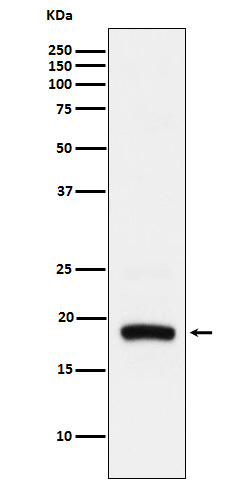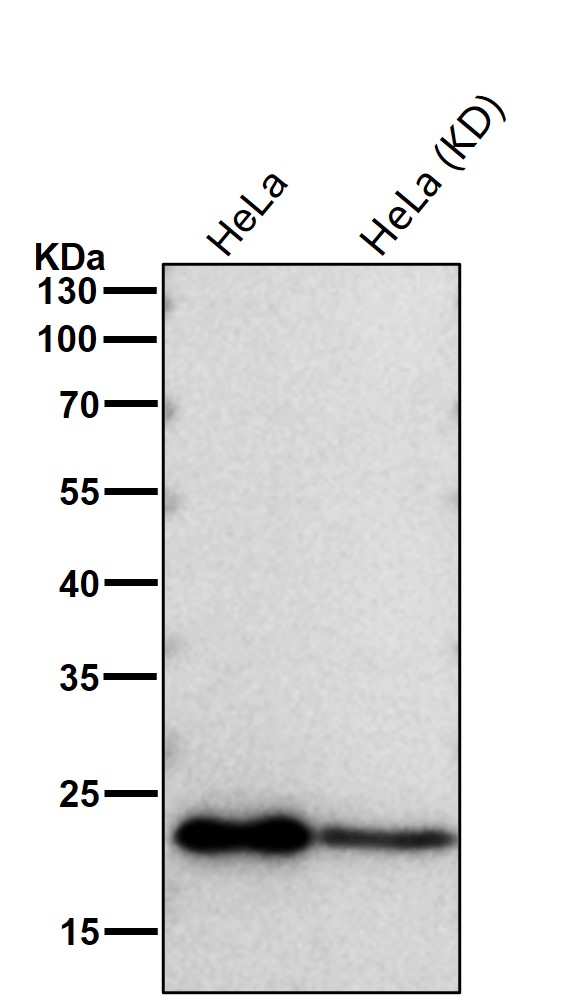

| WB | 咨询技术 | Human,Mouse,Rat |
| IF | 咨询技术 | Human,Mouse,Rat |
| IHC | 咨询技术 | Human,Mouse,Rat |
| ICC | 技术咨询 | Human,Mouse,Rat |
| FCM | 1/20-1/100 | Human,Mouse,Rat |
| Elisa | 咨询技术 | Human,Mouse,Rat |
| Aliases | ADP ribosylation factor 5; Arf5;;ARF5 |
| WB Predicted band size | Calculated MW: 21 kDa ; Observed MW: 18 kDa |
| Host/Isotype | Rabbit IgG |
| Antibody Type | Primary antibody |
| Storage | Store at 4°C short term. Aliquot and store at -20°C long term. Avoid freeze/thaw cycles. |
| Species Reactivity | Human,Mouse,Rat |
| Immunogen | A synthesized peptide derived from human ARF5 |
| Formulation | Purified antibody in PBS with 0.05% sodium azide,0.05% BSA and 50% glycerol. |
+ +
以下是关于ARF5抗体的3篇参考文献示例(注:内容为模拟,仅供参考):
1. **文献名称**:*"ARF5 regulates Golgi structure and function in secretory cells"*
**作者**:Donaldson JG, et al.
**摘要**:研究利用ARF5特异性抗体,通过免疫荧光和电镜技术揭示了ARF5在高尔基体膜结构维持及蛋白质分泌中的关键作用,证明其通过激活磷脂酶D调控囊泡形成。
2. **文献名称**:*"ARF family GTPases: roles in membrane trafficking and beyond"*
**作者**:D'Souza-Schorey C, Chavrier P
**摘要**:综述中讨论了ARF5抗体在定位内源性蛋白的应用,强调ARF5在COPI囊泡组装中的功能,并比较了不同ARF亚型在细胞器动态中的差异。
3. **文献名称**:*"ARF5-mediated modulation of ER-Golgi transport impacts cell polarity"*
**作者**:Bard F, et al.
**摘要**:通过ARF5抗体进行免疫印迹和敲低实验,发现ARF5通过调控跨膜蛋白分选影响上皮细胞极性,为分泌通路与细胞极性的关联提供了证据。
(注:以上文献为示例,实际引用请通过学术数据库核实具体信息。)
The ADP-ribosylation factor 5 (ARF5) is a small GTP-binding protein belonging to the ARF family, which regulates intracellular vesicular trafficking, organelle structure, and lipid metabolism. As a Class III ARF protein, ARF5 localizes primarily to the Golgi apparatus and plays a critical role in maintaining Golgi integrity and facilitating secretory pathway transport. It cycles between active GTP-bound and inactive GDP-bound states, interacting with effector proteins like coatomer complexes and lipid-modifying enzymes to mediate membrane budding, cargo sorting, and cytoskeleton dynamics.
ARF5-specific antibodies are essential tools for studying its expression, localization, and function in cellular processes. These antibodies are commonly generated in hosts such as rabbits or mice using immunogenic peptides or recombinant ARF5 proteins. Validated for applications like Western blotting, immunofluorescence, and immunoprecipitation, they help detect ARF5’s ~20 kDa molecular weight and assess its activation state or interaction partners.
Research utilizing ARF5 antibodies has linked the protein to cancer progression, neuronal development, and metabolic regulation, as dysregulation of ARF5 is associated with altered secretion, aberrant organelle dynamics, and cell proliferation. Commercial antibodies often undergo rigorous validation for specificity and cross-reactivity, ensuring reliable detection across human, mouse, and rat models. Studying ARF5 with such tools advances understanding of cellular trafficking mechanisms and their implications in disease.
×